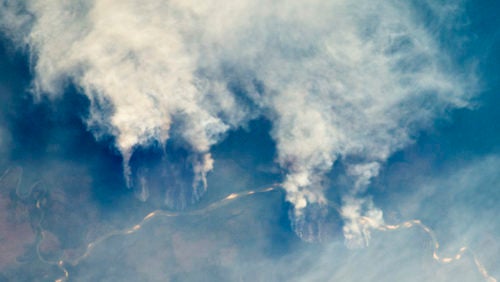Forest Fires: A Concern that Warrants More Attention
October 26, 2019 by ustin Holtshouser

With the consequences of forest fires being felt on both local and global levels, more needs to be done to mitigate these events – domestic government action is essential.
One area of environmental concern that does not attract enough attention is the burning of forests around the world. Forests not only account for approximately 31% of land on the planet, but also are home to about 80% of land-based animal species.[1] Forests are integrated ecosystems that play significant roles in carbon and water cycles.[2]
Currently, forests in the Amazon are burning at record rates. Brazil’s National Institute for Space Research reported that there were 72,843 fires in 2019 alone – an 80% increase from the previous year.[3] With forest fires on a steady rise, it is crucial to note how these fires affect the environment and life around the world.
One of the most prominent effects that forest fires have on the environment is the contribution to greenhouse gas emissions.[4] Forests act as a “carbon sink,” holding carbon that would otherwise contribute to existing greenhouse gas emissions.[5] However, when forests burn, that carbon is released, ultimately contributing to rising temperatures and noticeable changes in weather.[6] These effects can, in turn, contribute to the risk of biodiversity by transforming animal habitats, especially in regards to the availability of food and water.[7]
Additionally, these emissions can cause significant health problems. According to the Oswaldo Cruz Foundation, a public research institute, the forest fires currently taking place in the Brazilian Amazon are releasing not only carbon monoxide, but also nitrous oxide and toxic pollutants.[8] These pollutants can cause heart disease, cancer, respiratory problems, and nerve disorders.[9] Children are among the most vulnerable to such health risks because their lungs are not yet fully developed and, in comparison to adults, they spend more time outside.[10] Cities closer to the fires actually saw a 36% increase in children hospitalizations for respiratory issues.[11]
Lastly, because forests house a majority of the world’s land-based animal species, the continuation of forest fires will lead to the extinction of numerous species that are crucial to our world. Forest animals are unable to thrive in the small fragments of forest left behind after a devastating fire.[12]
With the consequences of forest fires being felt on both a local and global level, more needs to be done to mitigate these events. Currently, the World Wildlife Foundation (WWF) is using several approaches to help limit wildfires, but one organization can only do so much.[13] If significant changes are to be made, more domestic government action is essential.
Deforestation is a big driver of forest fires. A good starting point for governments would be to limit the location and amount of deforestation that takes place in domestic forests through policy regulations. Deforestation ultimately makes the cleared areas in forests much drier and easier to catch fire.[14] By limiting deforestation, countries will be able to manage these fires more easily because the annual number of fires will decrease and those that do occur will be in a concentrated area.
[1] World Wildlife Fund., Deforestation and Forest Degradation: Overview, World Wildlife Fund. (last visited Oct. 9, 2019), https://www.worldwildlife.org/threats/deforestation-and-forest-degradation.
[2] Id.
[3] Sarah Gibbens, The Amazon is Burning at Record Rates—and Deforestation is to Blame, Nat’l Geographic (Aug. 21, 2019), https://www.nationalgeographic.com/environment/2019/08/wildfires-in-amazon-caused-by-deforestation/.
[4] World Wildlife Fund, supra note 2.
[5] Id.
[6] Id.
[7] Id.
[8] Jessie Yeung, The Amazon Wildfires are Causing a Spike in Children’s Breathing Problems, Nat’l Geographic (Oct. 3, 2019), https://edition.cnn.com/2019/10/03/health/amazon-fire-children-breathing-intl-hnk-scli/index.html.
[9] Id.
[10] Id.
[11] Id.
[12] World Wildlife Fund., supra note 2.
[13] Id.
[14] See Elizabeth Lawrence, Why is the Amazon Rainforest on Fire?, USA Today (Aug. 22, 2019), https://www.usatoday.com/story/news/world/2019/08/22/amazon-fire-ngos-brazil-president-jair-bolsonaro-suggests-cause/2082066001/.

